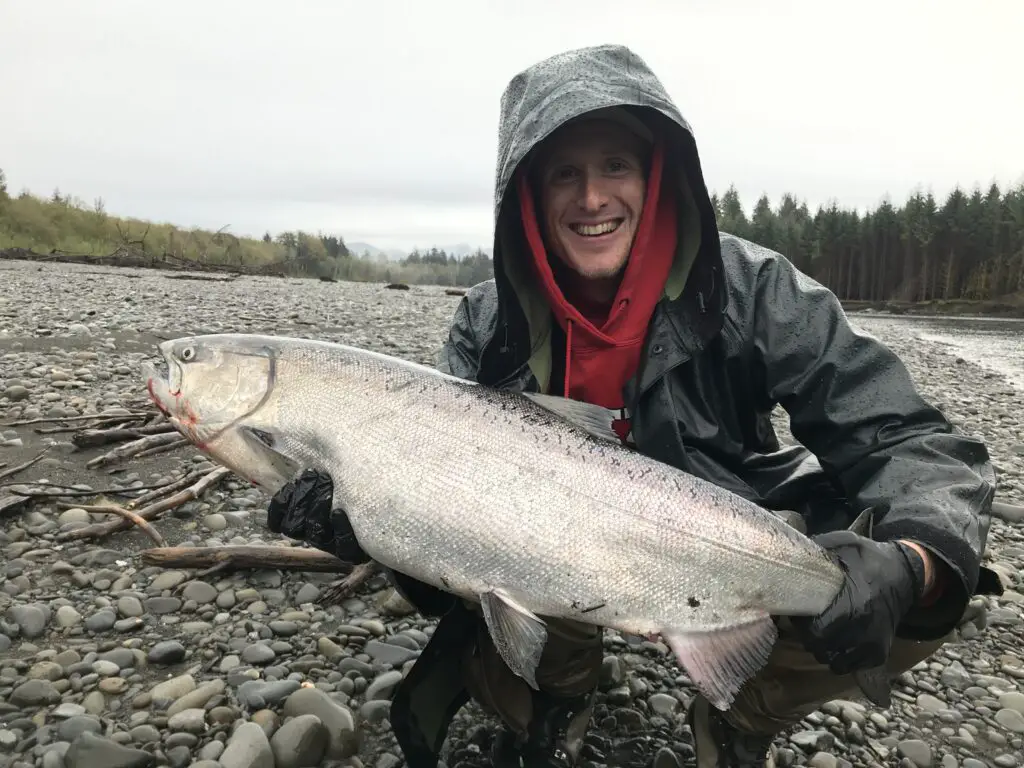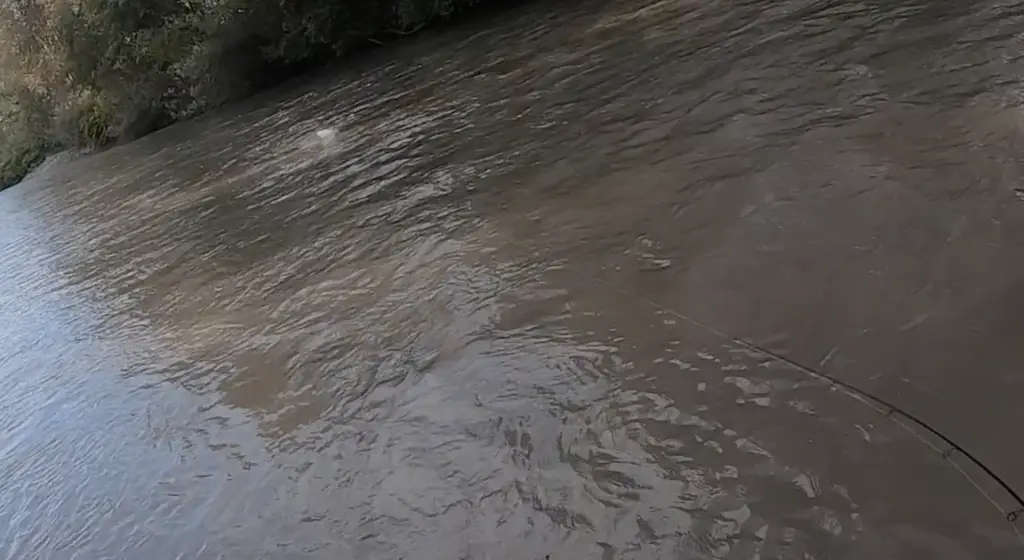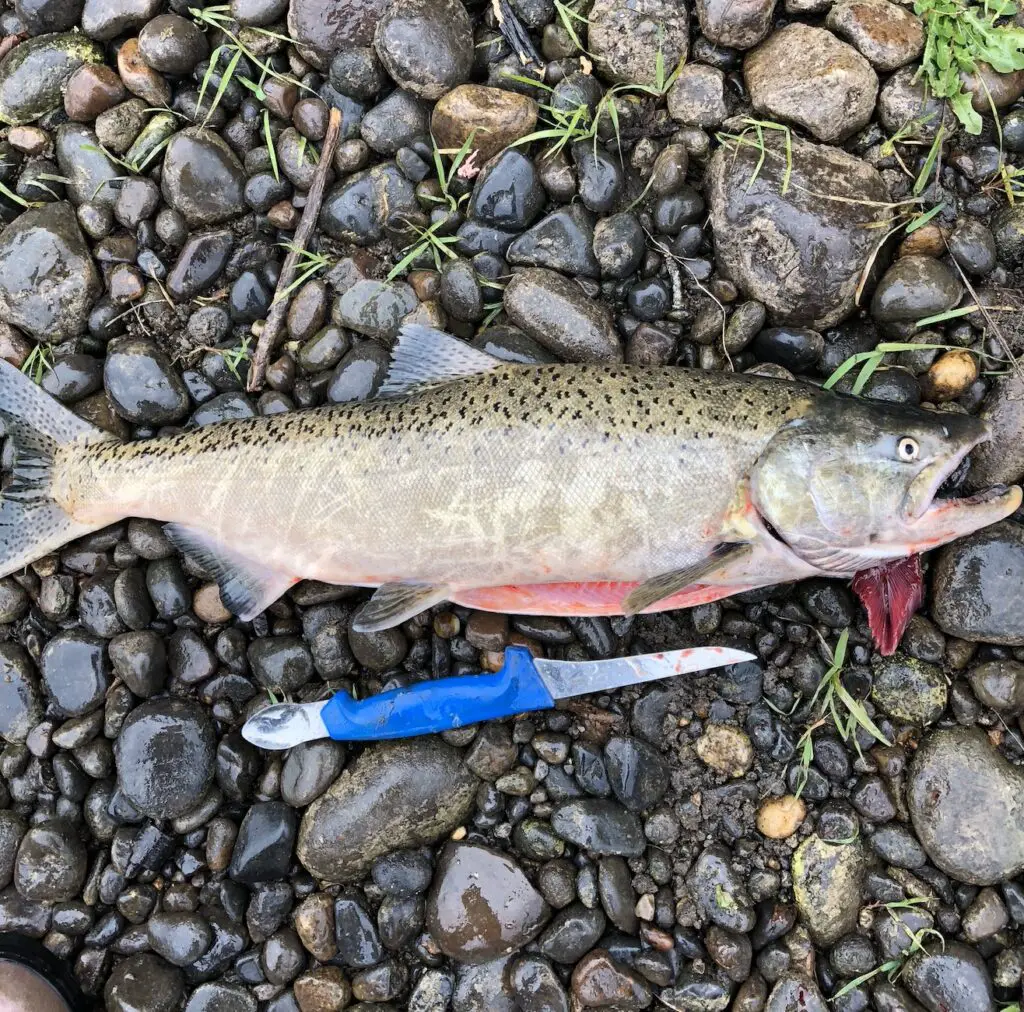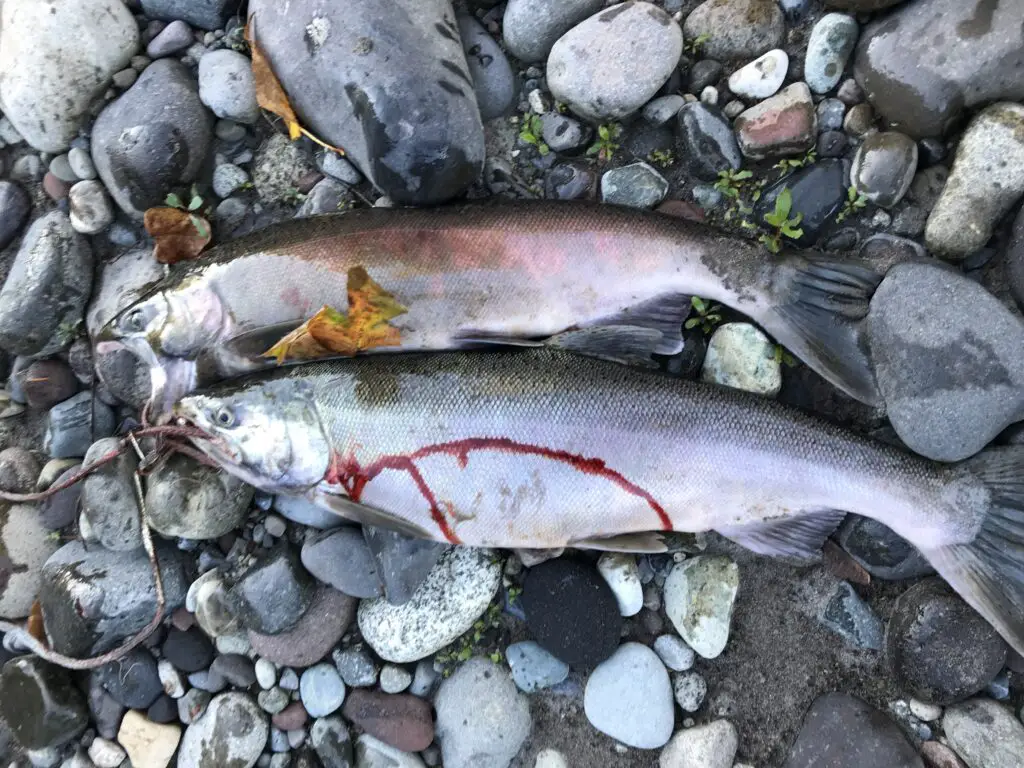
Drift fishing is one of the most common methods used to fish for salmon.
Walk down to your local river at a well-known and accessible gravel bar and you may see a line of anglers in the river all seemingly fishing together in close quarters.
These folks are typically all drift fishing.
Drift fishing involves a weight, a leader, and some terminal offering such as a drift bobber like a cheater or Lil’ corkie just above a hook which may also include yarn and/or bait such as cured roe.
A drift fisherman will cast upstream slightly and let the weight and terminal offering drift along in the current, hoping for a fish to bite.
Sometimes drift fishing is used to floss salmon. You can read more about that topic here.
Rigging up for drift fishing

Learning to detect the bite while drift fishing can be challenging because drift fishing involves a weight bouncing down the river transmitting a constant tap tap tap “feeling” to the angler.
The angler must learn to detect the difference between a salmon picking up the offering and the feel of the river bottom.
It’s important to have the right type of rod for this technique. A proper drift fishing rod for salmon may be rated 6-12 lb or 8-15 lb line strength, 1/4 to 3/4 oz lure weight. At least 8’6″, but 9 or 9’6″ are preferred to help mend the line.
Additionally, you want the tip of the rod to be sensitive (fast action), but the body to be on the stiffer side for pulling salmon out of the current.
We are an Amazon affiliate, so you are supporting our site by using our links, though it’s the same price regardless of how you shop.
If you are looking for more of a budget first rod to get started with though, checkout our post on the best fishing rod for salmon.
My preferred reel to drift fish with is a casting reel such as the Shimano Curado. I have several of them and it’s my favorite low profile casting reel I use for targeting salmon and steelhead.
I like drift fishing with a casting reel so I can quickly and seamlessly release slightly more line to keep my offering on the river bottom as it swings through the drift.
I spool all of my reels with a 30 lb high visibility braided line.
I tie this braided mainline directly to a weight system of some kind and the leader is made up of clear mono or fluorocarbon from 15-20 lb test strength.
Leader sizes range from 2 feet to 4 feet depending on water clarity. Hook sizes and flotation are important to match but vary based on whether I’m fishing bait, soft beads, or just scented yarn.
The amount of weight used should be matched to the current speed and bottom type.
In similar current speeds, you will need less weight if the bottom is made up of volleyball-sized rocks vs pebbles or gravel.
Also, higher current speeds require more weight. You want your weight to make steady progress downriver, maintaining contact with the bottom every few seconds depending on the bottom type.
With the gravel or mud-type bottom, your weight may be in contact the entire time and that’s okay as long as it’s not stopping due to bottom contact.
The drift fishing cast

Assuming the water is flowing from left to right in the below examples leveraging clock terminology.
In describing the cast, I often use clock terminology to describe the angle of the cast or your main line.

If a cast is made at 12 o’clock, you are assumed to be at the center of the clock and thus the cast would be directly in front of you.
Most of the time a cast is made at 11 o’clock, this is to ensure that the weight has time to sink to the bottom by about 12 o’clock.
You may need to cast between 10 and 11 o’clock to get that to happen depending on the current speed and appropriate amount of weight. You want to use a weight system that allows you to adjust rapidly as it’s common to need to experiment on the river until you get it dialed in.
When you are drift fishing to floss for salmon or have a chance at flossing, you always cast upstream to ensure that your leader and weight are largely drifting downstream together, to allow the line a chance to run through the mouth of a salmon traveling upstream with it’s mouth open.
You typically will retrieve your cast once it drifts down to about 1 o’clock as that’s where the parallel nature of your weight and leader typically stop as the leader swings more downstream as your rig begins to swing across the drift instead of down the drift.
Ironically, around the 1 o’clock position is where most actual bites happen while drifting fishing for salmon.
This is because your offering has now slowed down enough for a salmon to decide they want it and that it’s worth their energy to take a snap at it.
Often times when fishing for salmon, we are trying to appropriately slow down an offering to induce a bite.
Other times we are trying to create a completely natural presentation where our offering moves at the same speed as the river current. An object moving downstream rapidly may not result in a bite though.
This may be dependent on target species, river visibility level, etc.
If this is the case, then there’s a logical conclusion to modifying our drift fishing approach to optimize for producing bites.
Make the cast at 12 o’clock, use slightly more weight to ensure as your offering swings across and down the current that it maintains bottom contact vs coming up to the surface.
Let it swing from 12 o’clock to between 2 and 3 o’clock and slowly retrieve the offering while it maintains bottom contact.
Often times fish will bite between 1 and 2 o’clock. When I fish this way, I often will rig up on a sliding weight system, so that if a fish picks it up, I will feel it immediately.
What does the bite feel like when drift fishing for salmon?
This is the ultimate question for all new drift-fishing anglers. What does it feel like?
The question and notion are also slightly misleading.
If you are standing out there in the river, making cast after cast, waiting to feel a salmon, you might be somewhat disappointed as a salmon can pick up your offering and spit it out often before you will ever “feel” anything.

Think about it for a second, if you are using a 3 ft leader that is swinging downstream in front of your weight, and a salmon picks up your offering.
Before you will “feel” anything, that weight needs to travel almost 6 ft. Depending on current speed, that may take around 2 seconds, which is plenty of time for a salmon to have to spit your hook and you never would have felt anything.
There are two techniques that are better suited to figuring out the bite besides waiting all day to feel something.
First, stop watching your rod tip (feel the rod tip!), watch your line.
When a salmon picks up your offering, your mainline which is normally drifting downstream at an even pace, will slow down, or sometimes even stop.
At the same time, you will often stop feeling the bottom for a brief instance.
This is because, when a fish has picked up the offering, there is now resistance on your weight that stops it from moving downstream as fast.
Your weight may also come up off the bottom as a result of a salmon picking it up, so you will stop feeling the transmission of bottom to your rod tip.
This is when you set the hook, and you will often be rewarded by a loaded-up rod with a salmon at the other end.
Drift fishing with bait consideration
When you are fishing bait, it’s important to have a solid indication of a fish take or you will have to rebait on each swing and miss.
Additionally, if you are being watched by a game warden, and you are swinging and missing on every cast, you WILL get a ticket and be (rightly) accused of snagging.
Second method: The first method works great between 12 o’clock and 1 o’clock.
But once your line starts to swing across vs down the drift, your mainline will slow down quite a bit anyways.
If you are using a sliding weight system, this will help detect a bite as you will often feel a fish take.
However, sometimes you feel “something” and you aren’t sure. If you set the hook and miss, you may lose your bait, so instead just raise your rod up slightly.
If a salmon has taken your offering, you will immediately feel the weight and resistance as when you are pointed at 1 o’clock or further angled, assuming you have properly mended your line, you will have little to no slack in your line.
When you lift your rod tip and feel that resistance, then set the hook and immediately reel down to make sure you have a good connection to the fish.
There are times when you will directly feel a bite while drift fishing, but these are the minority of cases.
For other techniques of river fishing insights you can refer to our main river fishing for salmon page.